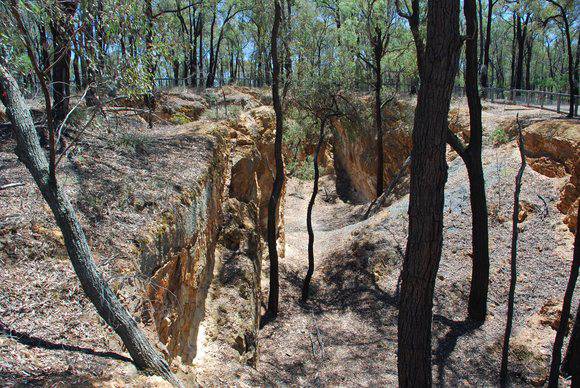| Back to search results » | Back to search page » |
|
MAGENTA QUARTZ MINE
Other NameCHILTERN STATE PARK Location145 MAGENTA ROAD CHILTERN, INDIGO SHIRE
File Number602113LevelRegistered |
|
Statement of Significance
What is significant? The Magenta Quartz Mine is of archaeological significance for its
potential to yield information concerning the technological history of
gold mining in Victoria.
Magenta Quartz Mine began as an open cut mine in 1860 on the
Magenta gold fields, 1.6km northeast of Chiltern in north eastern
Victoria. Following the discovery of gold in Victoria (1851), quartz
gold mining developed in the mid-1850s, subsequent to alluvial mining
practices, and intensified c.1860. Two separate Magenta quartz gold
mining syndicates operated on separate reefs at different periods. The
first Magenta Company remained in continuous operation until 1901 and
excavated the open cut mine using horse and dray. The second Magenta
Company, operating from c.1909 to the mid-1920s, mined an open stope
reef to the west using a steam powered winch and pulley system.
Mullock from the stope was dumped onto the open cut site filling in
many of the tunnels extending down past the cut. Published figures
indicate the mine yielded 9900 oz. of gold from 21 665 tons of crushed
material, although it is believed that 13000 oz. is a more accurate
sum.
Developing as a result of the rush to gold, Magenta was a
significant township during the late 1860s and remained an important
residential area up to 1907; World War I fostered its decline. The
Magenta reef was briefly reworked during the 1930s depression years.
The mining site is now open to tourists as part of the Chiltern
Box-Ironbark National Park.
The Magenta Quartz Mine site comprises an open cut mine measuring
50m x 30m x 8m deep and an open stope mine west of the open cut
measuring 20m x 5m x40m deep. The remains of two stamping batteries,
two intact sealed shafts, and tailings dumps are evident. The mine's
integrity has been moderately compromised due to disturbance of the
tailings and partial filling of the open cut.
Gold mining sites are of crucial importance for the pivotal role
they have played since 1851 in the development of Victoria. As well as
being a significant producer of Victoria's nineteenth century wealth,
quartz mining, with its intensive reliance on machinery, played an
important role in the development of Victorian manufacturing industry.
How is it significant?
Magenta Quartz Mine is of historical and archaeological
significance to the State of Victoria.
Why is it significant?
The Magenta Quartz Mine is historically important for its
association with the Victorian gold rush and in demonstrating the
contribution of quartz mining to Victoria's prosperity from gold.
(Online Data Upgrade Project 2007)
Group
Mining and Mineral Processing
Category
Gold Mining Site





